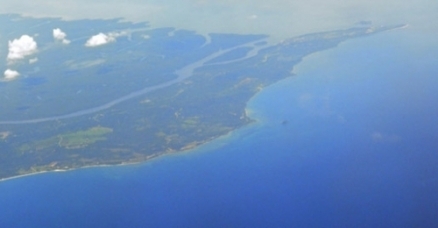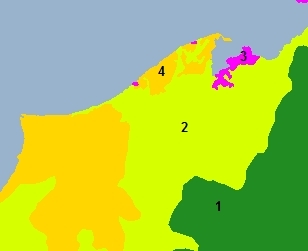Ecoregions of Brunei
Ecoregions of Countries Collection 
WWF identifies four ecoregions that exist entirely or in part in Brunei:
- Borneo montane rainforests occupy a small tip of southeastern Brunei at the location of the Ulu Temburong National Park;
- Borneo lowland rainforests, cover most of the nation of Brunei and consist of a highly biodiverse dipterocarp tropical forest assembly;
- Sunda Shelf mangroves are found along parts of the South China Sea and Brunei Bay margins; and,
- Borneo peat swamp forests occupy most of the near coastal areas along the South China Sea;
Contents
Borneo montane rainforests
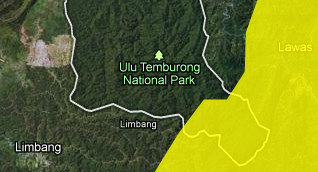 Brunei's Borneo montane rainforests (in green). WWF See main article: Borneo montane rainforests
Brunei's Borneo montane rainforests (in green). WWF See main article: Borneo montane rainforests
Borneo montane rainforests cover the small area of the southeastern extremity of the nation of Brunei. These forests comprise the higher elevation portions of the Ulu Temburong National Park. The geographic isolation of this forest type has produced a unique and diverse set of montane species. Of Borneo's endemic bird species, twenty-three (73 percent) are montane. There are more than 150 mammalspecies in montane forests, making this ecoregion globally outstanding for mammal richness, and it is the most speciose montane rain forest found in the Indo-Pacific region. Despite this wealth of diversity, sizable tracts of Borneo's montane forests have not been explored to allow the cataloging of their flora and fauna.
Borneo lowland rainforests
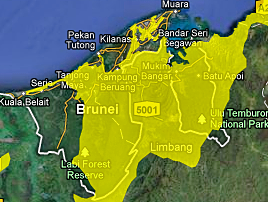 Bruenei's Borneo lowland rainforests (in green). WWF.
Bruenei's Borneo lowland rainforests (in green). WWF.
See main article: Borneo lowland rainforests
Borneo lowland rainforests comprise the largest ecoregion of Brunei, covering most of the interior of the country. This ecoregion exhibits the richest rainforests in the world and rival the biodiversity of New Guinea and the Amazon. The geology of this area consists of limestones, volcanic rocks, schist-gneiss complexes and sedimentary rocks. Notable protected areas of the Borneo lowland forests within Brunei include Labi Forest Reserve and Bukit Ladan Forest Reserve.
With 267 Dipterocarpaceae species (155 endemic to Borneo), Borneo is the center of the Earth's diversity of dipterocarps. These forests are home to the world's smallest squirrel, the eleven centimeter long pygmy squirrel, and the endangered orangutan. These forests are globally outstanding for both bird and plant richness, with more than 380 birds and an estimated 10,000 plant species found within its boundaries.
Sunda Shelf mangroves
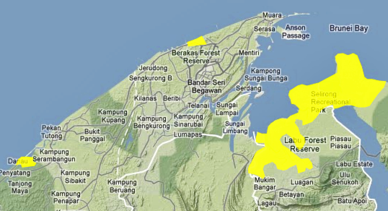 Brunei's Sunda Shelf mangroves (in yellow). WWF
Brunei's Sunda Shelf mangroves (in yellow). WWF
See main article: Sunda Shelf mangroves
There are a number of major mangrove types, or consociations, recognized within the Sunda Shelf mangroves, based on the dominant species within the genera of Avicennia, Rhizophora, Sonneratia, Bruguiera, and Nypa. The relative occurrence of each type is based on fluctuations in soils, salinity, and the tidal regime. Typically, mangroves display a zonation or Succession of forests, with each zone being dominated by one of the consociations. On the seaward sediments, Avicennia-Sonneratia forest dominates. Moving inland, there are typically softer and deeper mud sediment dominated by Rhizophora-Bruguiera forests. Further inland, the soils become firmer and the forests display a greater species diversity. In areas with a substantial freshwater influence, Nypa palms dominate.
This mangrove ecoregion occurrence within Brunei occurs chiefly: (a) near Danau; (b) on the coastline at the Berakas Forest Reserve; and (c) at coastal areas of the Selirong Recreation Park on Selirong Island. At the last of these three locales does the ecoregion extend farthest inland. Several primates including the Long-tailed macaque are found in this ecoregion.
Borneo peat swamp forests
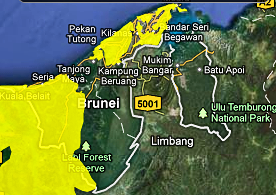 Borneo peat swamp forests (yellow) in Brunei. WWF See main article: Borneo peat swamp forests
Borneo peat swamp forests (yellow) in Brunei. WWF See main article: Borneo peat swamp forests
Borneo peat swamp forests cover considerable portions of the island of Borneo in lowland areas; moreover, these forests occupying most of Brunei's coastal zone along the South China Sea. are not as biodiverse as neighboring lowland rainforests—the Borneo peat swamp forests—categorized by the WWF as unit IM0104 are among the most speciose peat swamp forests of Southeast Asia. These peat swamp forests are a key habitat for the unique and endangered Borneo endemic proboscis monkey (Nasalis larvatus). Also, they are home to the world's most desirable aquarium fish, the arowana (Scleropages formosus).
Based on the Köppen climate zone system, the Borneo peat swamp forests are within the tropical wet climate zone. The peat swamp forests of Brunei have plant association and edaphic characteristics similar to Sabah, Sumatra and peninsular Malaysia (Geography of Malaysia). The peat soil is chiefly organic matter, which builds up inland of mangrove swamps. These soils are rain-fed, and are recent in origin. Such peat swamp forests form when sediments accumulate on the backshores of mangroves as rivers drain toward the coastal zone.
Context
Ecoregions are areas that:
[1] share a large majority of their species and ecological dynamics;
[2] share similar environmental conditions; and,
[3] interact ecologically in ways that are critical for their long-term persistence.
Scientists at the World Wildlife Fund (WWF), have established a classification system that divides the world in 867 terrestrial ecoregions, 426 freshwater ecoregions and 229 marine ecoregions that reflect the distribution of a broad range of fauna and flora across the entire planet.
References
- E.F.Brünig. 1973. Species richness and stand diversity in relation to site and succession of forests in Sarawak and Brunei (Borneo). Amazoniana' 4: 293-320.
- Colby Loucks. 2001. Borneo montane rainforests. in Terrestrial ecoregions of the Indo-Pacific: a conservation assessment. World Wildlfe Fund. Island Press
- Li and Sun. 1999. Palynological records since Last Glacial Maximum from a deep-sea core in the southern South China Sea. Quat. Sci. Rev. 23: 2007-2016
- B.P.C.Maguire and P.S.Ashton. 1977. Pakaramoideae, Dipterocarpaceae of the western hemisphere. II. Systematic, geographic, and phyletic considerations. Taxon 26:359-368.
- Alistar I.Robertson. 1992. Tropical mangrove ecosystems. American Geophysical Union. 329 pages
- Pinxian Wang. 2009. The South China Sea: Paleoceanography and Sedimentology (Google eBook) Springer. 506 pages
- Eric D.Wikramanayake. 2002. Terrestrial ecoregions of the Indo-Pacific: a conservation assessment. Island Press. 643 pages
